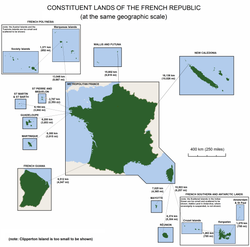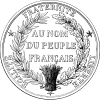
Back Franse oorsese gebiede Afrikaans مقاطعات وأقاليم ما وراء البحار الفرنسية Arabic Francia d'ultramar AST Fransa Dənizaşırı Bölgələr Birliyi Azerbaijani Заморскія ўладанні Францыі Byelorussian Отвъдморски департаменти и територии на Франция Bulgarian Bro-C'hall tramor Breton Territoris d'Ultramar Francesos Catalan Zámořská Francie Czech Францин тинĕс енчи çум пĕрлешĕвĕ CV
Overseas France France d'outre-mer (French) | |
|---|---|
| Motto: "Liberté, égalité, fraternité" "Liberty, Equality, Fraternity" | |
| Anthem: La Marseillaise ("The Marseillaise") | |
| Great Seal: | |
 Territory of the French Republic (red) Overseas territories (circled) Claimed territory (Adélie Land; hatched) | |
 | |
| Capital | Paris |
| Largest settlements | Fort-de-France (Martinique), Pointe-à-Pitre (Guadeloupe), Saint Denis (La Réunion), Saint Pierre (La Réunion), Nouméa (New Caledonia) |
| Languages | French, Antillean Creole, Guianan Creole, Reunionese Creole, Shimaore, Tahitian, Marquesan, 'Uvean, Futunan, Drehu, Nengone, Paicî, Ajië, Javanese, and 35 other native languages of New Caledonia |
| Demonym(s) | French |
| Territories | |
| Leaders | |
| Emmanuel Macron | |
• Minister | Manuel Valls |
| Area | |
• Total | 120,396[note 2] km2 (46,485 sq mi) |
| Population | |
• Estimate | 2,834,000 (Jan. 2024) |
| Currency | Euro CFP Franc |
| Date format | dd/mm/yyyy (AD) |
| This article is part of a series on the |
| Administrative divisions of France |
|---|
 |
| Administrative divisions |
| Intercommunality |
| Communes |
| Overseas France |
| Geocodes of France |
|
|
|
|
Overseas France (French: France d'outre-mer, also France ultramarine)[note 3] consists of 13 French territories outside Europe, mostly the remnants of the French colonial empire that remained a part of the French state under various statuses after decolonisation. Most are part of the European Union.
"Overseas France" is a collective name; while used in everyday life in France, it is not an administrative designation in its own right. Instead, the five overseas regions have exactly the same administrative status as the thirteen metropolitan regions; the five overseas collectivities are semi-autonomous; and New Caledonia is an autonomous territory. Overseas France includes island territories in the Atlantic, Pacific and Indian Oceans, French Guiana on the South American continent, and several peri-Antarctic islands as well as a claim in Antarctica. Excluding the district of Adélie Land, where French sovereignty is effective de jure by French law, but where the French exclusive claim on this part of Antarctica is frozen by the Antarctic Treaty (signed in 1959), overseas France covers a land area of 120,396 km2 (46,485 sq mi)[3] and accounts for 18.0% of the French Republic's land territory.[4] Its exclusive economic zone (EEZ) of 9,825,538 km2 (3,793,661 sq mi) accounts for 96.7% of the EEZ of the French Republic.[5]
Outside Europe, four broad classes of overseas French territorial administration currently exist: overseas departments/regions, overseas collectivities, the sui generis territory of New Caledonia, and uninhabited territories. From a legal and administrative standpoint, these four classes have varying legal status and levels of autonomy, although all permanently inhabited territories have representation in both France's National Assembly and Senate, which together make up the French Parliament.
2,834,000 people lived in overseas France in January 2024.[6] Most of these residents are citizens of France and citizens of the European Union. This makes them able to vote in French and European elections.
- ^ Article II of the Constitution of France (1958)
- ^ "The lictor's fasces". elysee.fr. 20 November 2012.
- ^ Larousse, Éditions. "Encyclopédie Larousse en ligne – France d'outre-mer". larousse.fr (in French). Retrieved 2 October 2022.
- ^ Land area of the four old overseas departments ([1]), Mayotte, the overseas collectivities, and New Caledonia (page 21), the French Southern and Antarctic Lands and the Scattered Islands ([2] Archived 19 June 2018 at the Wayback Machine), and Clipperton ([3] Archived 5 March 2020 at the Wayback Machine).
- ^ "Sea Around Us – Fisheries, Ecosystems and Biodiversity". Retrieved 20 June 2018.
- ^ The population of all five overseas departments totaled 2,230,000 in January 2024.[4] The population of the overseas collectivities and New Caledonia amounted to 604,000 inhabitants (Saint-Pierre and Miquelon [5], Saint-Barthélemy [6], Saint-Martin [7], French Polynesia [8], Wallis et Futuna [9], New Caledonia [10]).
Cite error: There are <ref group=note> tags on this page, but the references will not show without a {{reflist|group=note}} template (see the help page).

![Emblem[note 1] of](http://upload.wikimedia.org/wikipedia/commons/thumb/b/b7/Armoiries_r%C3%A9publique_fran%C3%A7aise.svg/85px-Armoiries_r%C3%A9publique_fran%C3%A7aise.svg.png)

